Hematocrit Test Devices Market Size
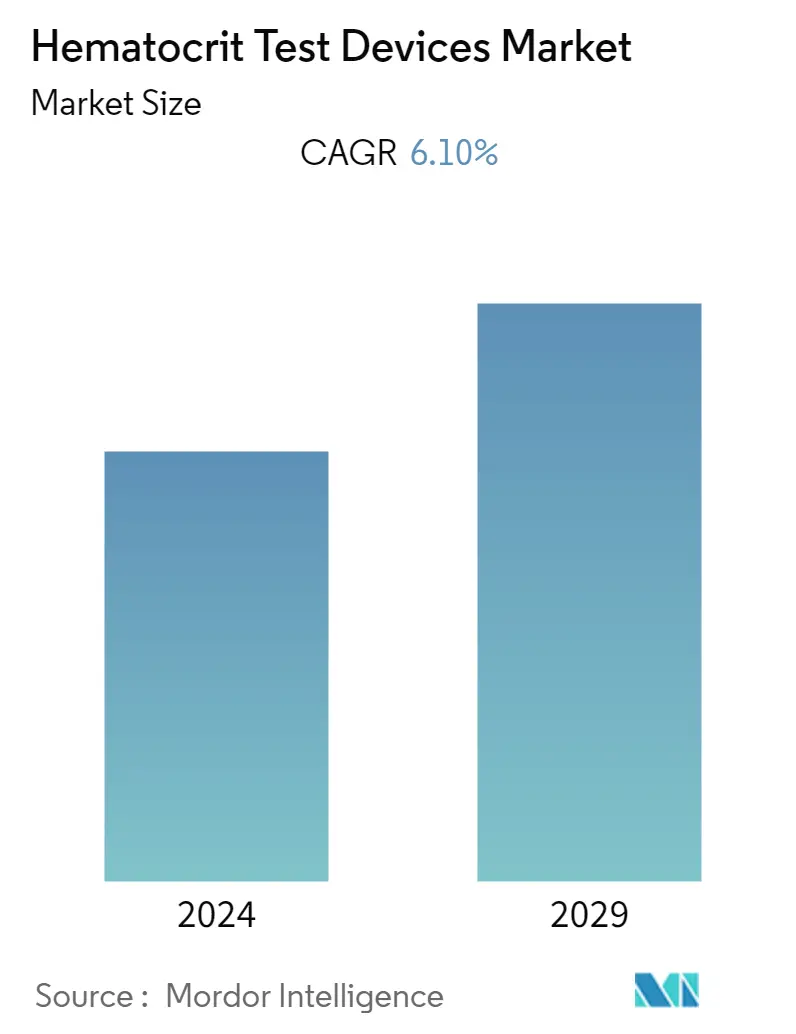
| Study Period | 2019 - 2029 |
| Base Year For Estimation | 2023 |
| CAGR | 6.10 % |
| Fastest Growing Market | Asia-Pacific |
| Largest Market | North America |
| Market Concentration | Medium |
Major Players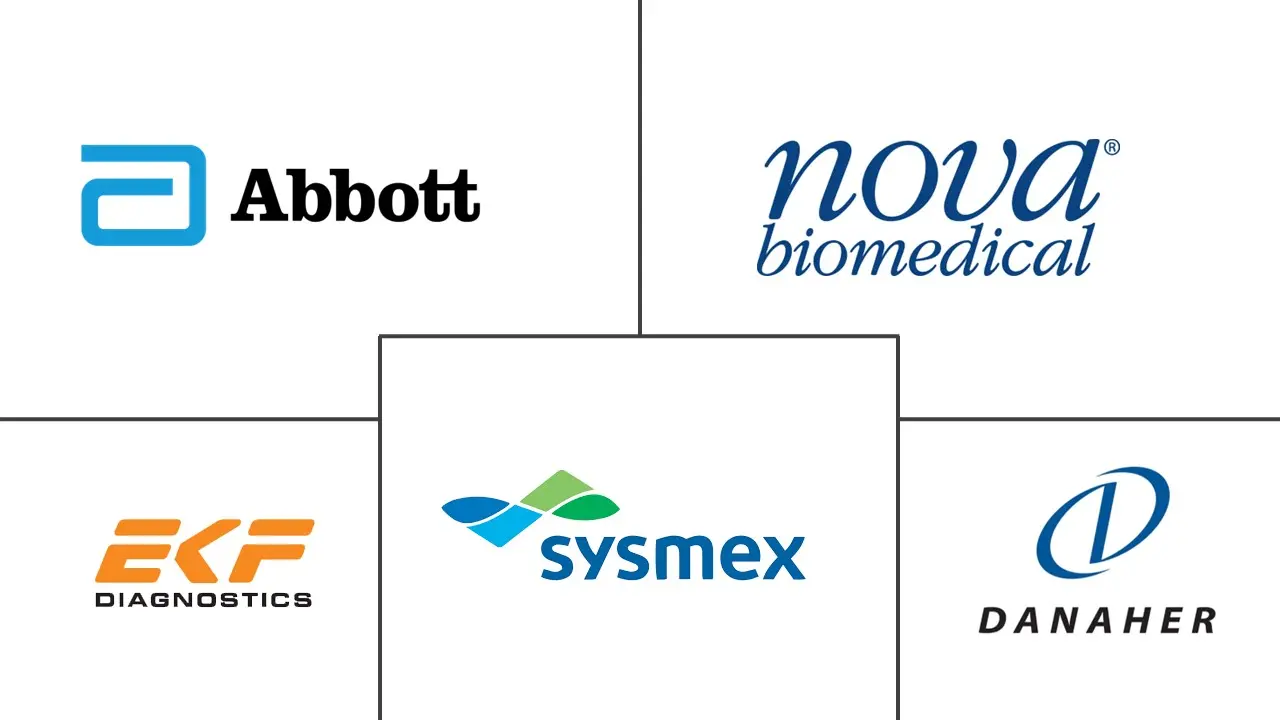
*Disclaimer: Major Players sorted in no particular order |
Hematocrit Test Devices Market Analysis
The hematocrit test devices market is expected to register a CAGR of 6.1% over the forecast period.
The COVID-19 pandemic had a significant impact on the hematocrit test devices market. The blood test used increased during the pandemic to diagnose COVID-19 patients. For instance, according to a study published in the MDPI Journal in November 2021, the clinical course of COVID-19 individuals admitted with mild disease can be tracked using regular hematology tests. Additionally, as per the study published in the NCBI in February 2022, patients with severe COVID-19 showed an increase in hematological changes, indicating a progressive worsening as COVID-19 severity progressed. Hence, it proposed that monitored hematological alterations in patients with COVID-19 played an important role in managing the disease and preventing the risk of a severe course of the disease. Thus, hematocrit testing was increasingly used to identify the physiological alterations in the blood component of COVID-19 patients during COVID-19 and led to significant growth.
The high prevalence of anemia and other blood disorders worldwide is expected to be a major driving factor for the growth of hematocrit test devices. Iron deficiency anemia is a common health problem that affects children under the age of five. For instance, according to a research study published in NCBI in July 2022, the global pooled prevalence (till 2021) of iron deficiency anemia and iron deficiency in children was 16.42% and 17.95%, respectively. Iron deficiency and anemia are very common, especially in Asia and Africa. Therefore, to reduce their complications, regular screening and treatment of iron deficiency and iron deficiency anemia are required, especially in high-risk children. Thus, the significant burden of anemia globally is expected to spur the demand for hematocrit test devices, thereby boosting the market.
The increasing geriatric population is further expected to augment the demand for hematocrit tests as they are more prone to chronic diseases and often require routine checkups. According to the United Nations World Population Prospects 2022, the share of the global population aged 65 years or above is projected to rise from 10% in 2022 to 16% by 2050. It is also estimated that, by 2050, the number of persons aged 65 years or over worldwide is projected to be more than twice the number of children under age five and about the same as the number of children under age 12. Thus, the increasing geriatric population worldwide is likely to create demand for blood tests, ultimately contributing to the market's growth.
However, stringent regulations regarding test devices and less awareness about the hematocrit test are expected to restrain the growth of the market during the forecast period.
Hematocrit Test Devices Market Trends
Anemia Segment is Expected to Hold a Significant Market Share Over the Forecast Period
A hematocrit test is a simple blood test that measures the percentage of red blood cells. Anemia is defined as a hematocrit level below the normal range, showing insufficient red blood cells. Thus, the hematocrit test has great significance in the diagnosis of anemia.
The rising prevalence of anemia is expected to increase the demand for hematocrit tests, thereby boosting the segment's growth. For instance, according to the fifth round of the National Family Health Survey (NFHS-5) of 2019-21, by the Indian government published in March 2022, at least 67% of children (6-59 months) have anemia, compared to 58.6% in the last survey conducted in 2015-16. Hence, due to the high prevalence of anemia, the demand for hematocrit test devices for anemia is expected to increase over the forecast period.
Government initiatives to increase anemia awareness are expected to increase the demand for hematocrit tests. For instance, in May 2021, the Women and Child Development Department started the 'Anemia Campaign 12' that aims to create awareness about low hemoglobin levels among women and children. Thus, this will likely create demand for hematocrit tests, thereby supporting the market's growth.
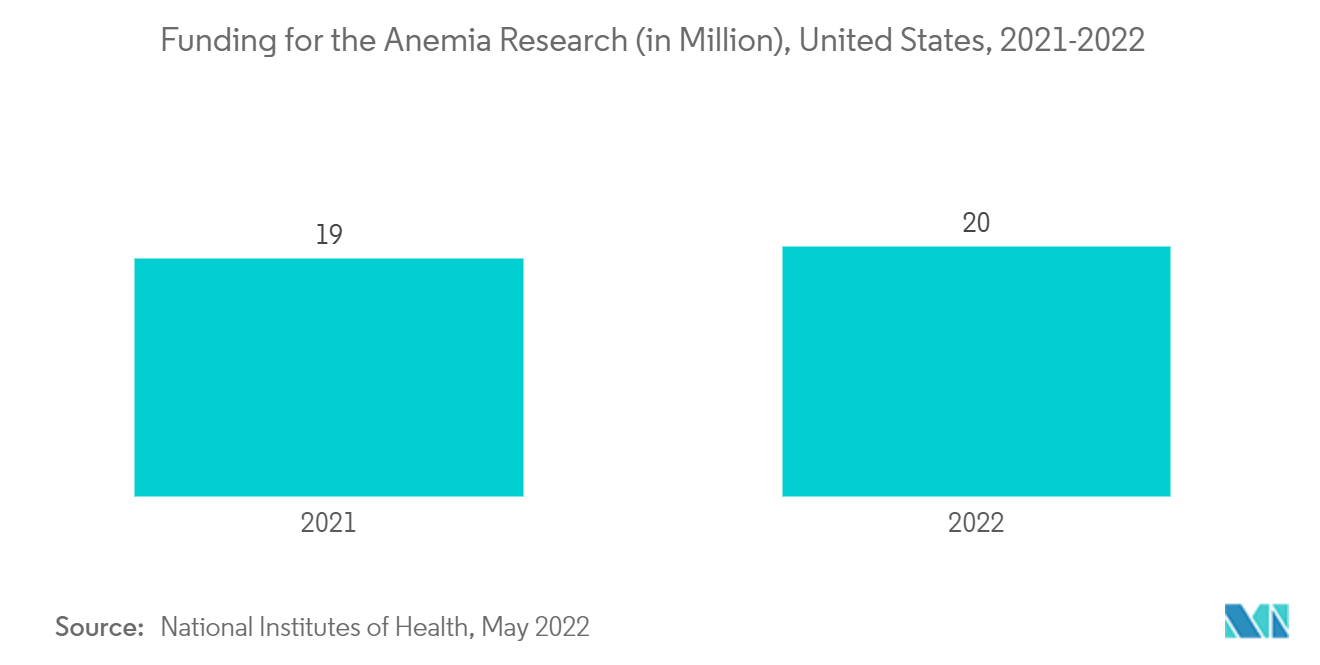
North America is Expected to Hold a Significant Share in the Market During the Forecast Period
North America is expected to hold a significant share in the hematocrit test devices market owing to the region's high burden of blood disorders and the rising geriatric population. For instance, according to the research study published in Hematology Journal in August 2022, the prevalence of anemia is rising in the United States. Females are twice as likely to have anemia as males. African Americans are three times more likely than white people to develop anemia. Hence, with the significant burden of different blood disorders, the hematocrit test devices market is expected to grow over the forecast period.
In the North American region, the United States is expected to hold a significant share of the region owing to the presence of robust healthcare infrastructure, the high burden of blood disorders, and the older population. For instance, according to the January 2022 update from the Centers for Disease Control and Prevention (CDC), about 890,000 visits to emergency departments with anemia were recorded in the United States in 2021.
Product launches by the market players are expected to propel the market's growth. For instance, in June 2022, Sysmex America Inc. received FDA clearance for the addition of residual white blood cell counting to its XN-10 Automated Hematology Analyzer with Blood Bank mode.
Therefore, owing to such factors, the North American region is expected to hold a significant share of the market.
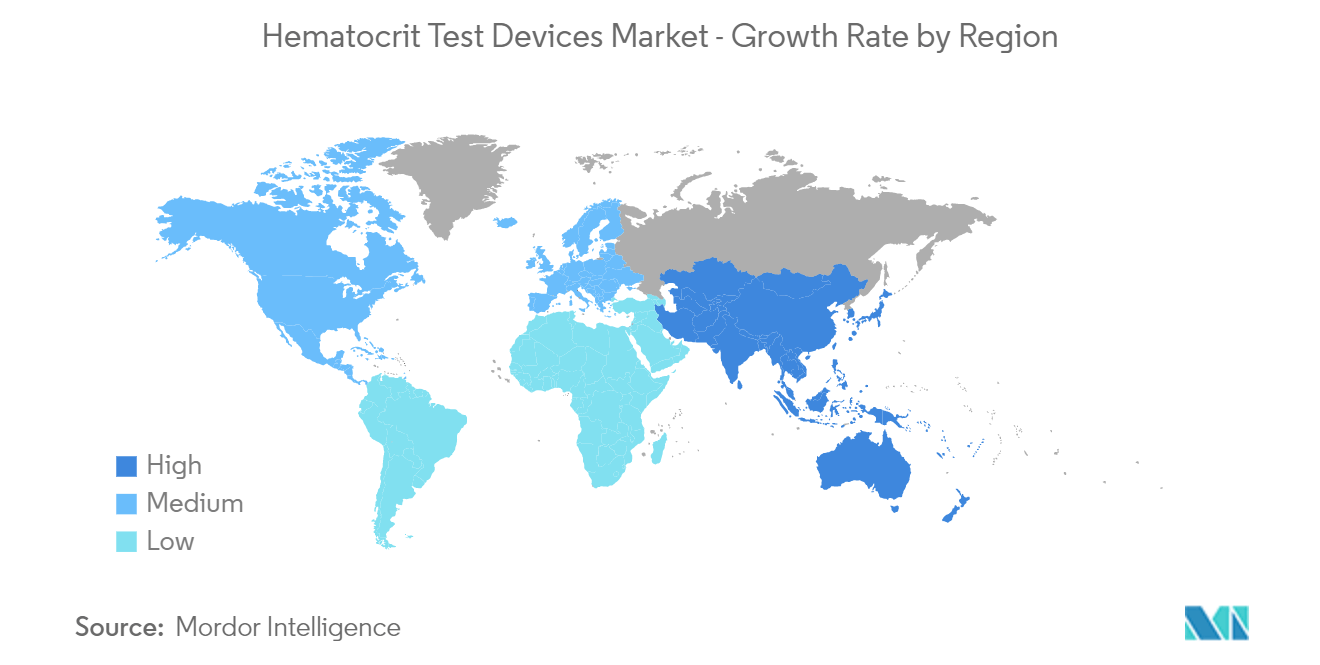
Hematocrit Test Devices Industry Overview
The hematocrit test devices market is moderately competitive, with many players in the market offering their innovative products. Some of the companies currently dominating the market are Abbott Laboratories, Boule Diagnostics AB, Danaher Corporation, EKF Diagnostics, F. Hoffman-La Roche Ltd, HORIBA Ltd, Nova Biomedical, and Sysmex Corporation.
Hematocrit Test Devices Market Leaders
-
Abbott Laboratories
-
EKF Diagnostics
-
Nova Biomedical
-
Sysmex Corporation
-
Danaher Corporation
*Disclaimer: Major Players sorted in no particular order
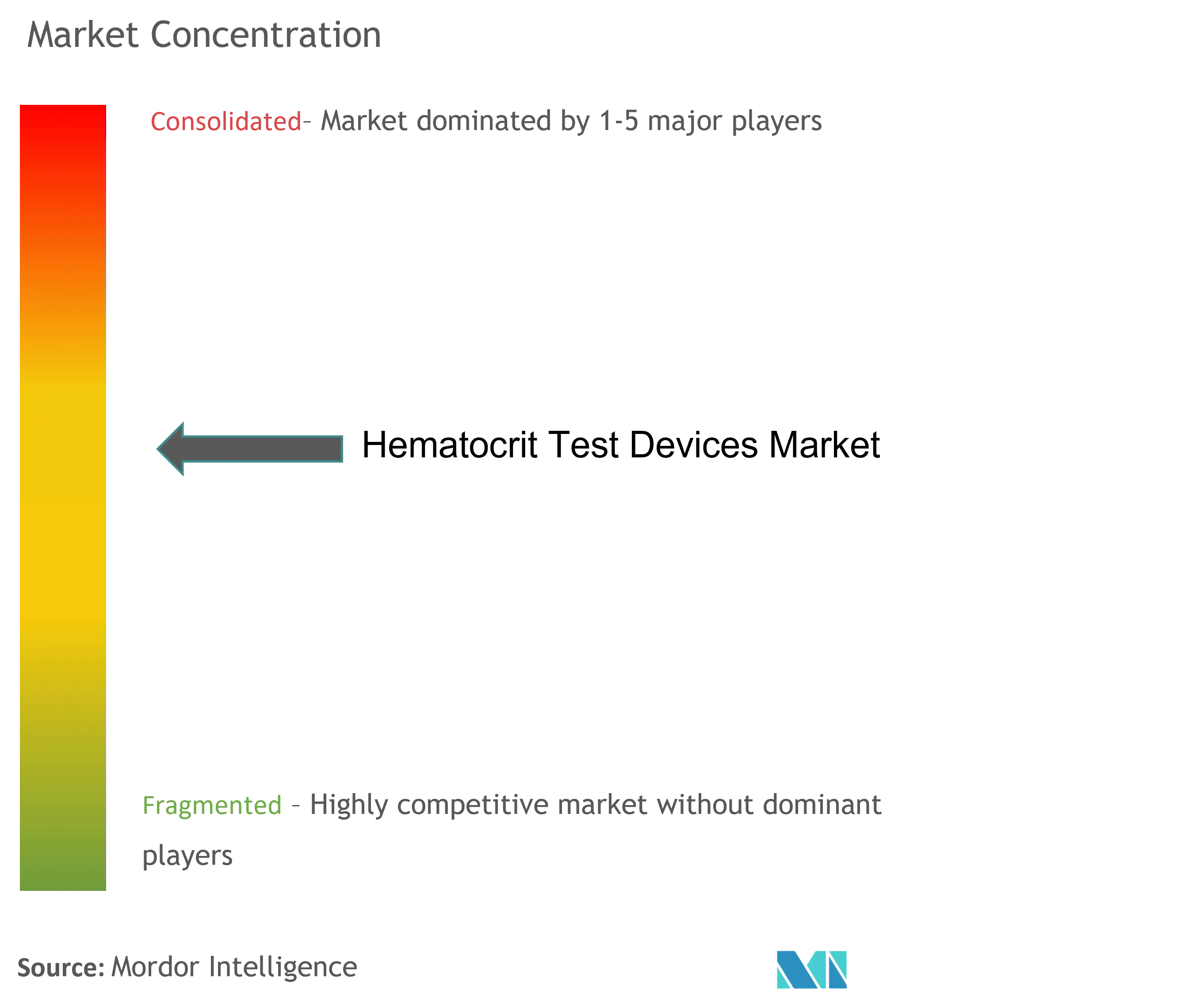
Hematocrit Test Devices Market News
- In April 2022, Sysmex Europe launched its new three-part differential automated hematology analyzer XQ-320, which brings excellence in quality to a diverse range of clinical laboratory environments with reliable technology and a new level of usability.
- In March 2022, Mindray launched BC-700 Series Integrated CBC and ESR hematology analyzer for small-to-mid-sized laboratories.
Hematocrit Test Devices Market Report - Table of Contents
1. INTRODUCTION
- 1.1 Study Assumptions and Market Definition
- 1.2 Scope of the Study
2. RESEARCH METHODOLOGY
3. EXECUTIVE SUMMARY
4. MARKET DYNAMICS
- 4.1 Market Overview
-
4.2 Market Drivers
- 4.2.1 Rising Prevalence Rates of Anemic Conditions
- 4.2.2 Growing Geriatric Population with Blood Disorders
-
4.3 Market Restraints
- 4.3.1 Stringent Regulatory Approvals and Lack of Awareness About Hematocrit Test
-
4.4 Porter's Five Forces Analysis
- 4.4.1 Threat of New Entrants
- 4.4.2 Bargaining Power of Buyers/Consumers
- 4.4.3 Bargaining Power of Suppliers
- 4.4.4 Threat of Substitute Products
- 4.4.5 Intensity of Competitive Rivalry
5. MARKET SEGMENTATION (Market Size by Value - USD million)
-
5.1 By Product
- 5.1.1 Hematocrit Test Meter
- 5.1.2 Hematocrit Test Analyzer
- 5.1.3 Reagents and Consumables
-
5.2 By Application
- 5.2.1 Anemia
- 5.2.2 Polycythemia Vera
- 5.2.3 Congenital Heart Diseases
- 5.2.4 Other Applications
-
5.3 By End User
- 5.3.1 Hospitals
- 5.3.2 Diagnostic Centers
- 5.3.3 Other End Users
-
5.4 By Geography
- 5.4.1 North America
- 5.4.1.1 United States
- 5.4.1.2 Canada
- 5.4.1.3 Mexico
- 5.4.2 Europe
- 5.4.2.1 Germany
- 5.4.2.2 United Kingdom
- 5.4.2.3 France
- 5.4.2.4 Italy
- 5.4.2.5 Spain
- 5.4.2.6 Rest of Europe
- 5.4.3 Asia-Pacific
- 5.4.3.1 China
- 5.4.3.2 Japan
- 5.4.3.3 India
- 5.4.3.4 Australia
- 5.4.3.5 South Korea
- 5.4.3.6 Rest of Asia-Pacific
- 5.4.4 Middle East and Africa
- 5.4.4.1 GCC
- 5.4.4.2 South Africa
- 5.4.4.3 Rest of Middle East and Africa
- 5.4.5 South America
- 5.4.5.1 Brazil
- 5.4.5.2 Argentina
- 5.4.5.3 Rest of South America
6. COMPETITIVE LANDSCAPE
-
6.1 Company Profiles
- 6.1.1 Abbott Laboratories
- 6.1.2 Boule Diagnostics AB
- 6.1.3 Danaher Corporation
- 6.1.4 EKF Diagnostics
- 6.1.5 F. Hoffmann-La Roche Ltd
- 6.1.6 HORIBA Ltd
- 6.1.7 Nova Biomedical
- 6.1.8 Siemens Healthineers
- 6.1.9 Sysmex Corporation
- 6.1.10 Nihon Kohden Corporation
- 6.1.11 Sensa Core
- *List Not Exhaustive
7. MARKET OPPORTUNITIES AND FUTURE TRENDS
** Subject To AvailablityHematocrit Test Devices Industry Segmentation
As per the scope of the report, a hematocrit test is part of a complete blood count that measures different components of the blood. Hematocrit test helps in diagnosing blood disorders such as anemia, polycythemia vera, and others. The hematocrit is typically measured from a blood sample by an automated machine that makes several other measurements of the blood at the same time.
The hematocrit test devices market is segmented by product (hematocrit test meter, hematocrit test analyzer, and reagents and consumables), application (anemia, polycythemia vera, congenital heart disease, and other applications), end user (hospitals, diagnostic centers, and other end users), and geography (North America, Europe, Asia-Pacific, Middle East and Africa, and South America). The report also covers the estimated market sizes and trends of 17 countries across major regions globally. The report offers values (in USD million) for the above segments.
| By Product | Hematocrit Test Meter | |
| Hematocrit Test Analyzer | ||
| Reagents and Consumables | ||
| By Application | Anemia | |
| Polycythemia Vera | ||
| Congenital Heart Diseases | ||
| Other Applications | ||
| By End User | Hospitals | |
| Diagnostic Centers | ||
| Other End Users | ||
| By Geography | North America | United States |
| Canada | ||
| Mexico | ||
| By Geography | Europe | Germany |
| United Kingdom | ||
| France | ||
| Italy | ||
| Spain | ||
| Rest of Europe | ||
| By Geography | Asia-Pacific | China |
| Japan | ||
| India | ||
| Australia | ||
| South Korea | ||
| Rest of Asia-Pacific | ||
| By Geography | Middle East and Africa | GCC |
| South Africa | ||
| Rest of Middle East and Africa | ||
| By Geography | South America | Brazil |
| Argentina | ||
| Rest of South America |
Hematocrit Test Devices Market Research FAQs
What is the current Hematocrit Test Devices Market size?
The Hematocrit Test Devices Market is projected to register a CAGR of 6.10% during the forecast period (2024-2029)
Who are the key players in Hematocrit Test Devices Market?
Abbott Laboratories, EKF Diagnostics, Nova Biomedical, Sysmex Corporation and Danaher Corporation are the major companies operating in the Hematocrit Test Devices Market.
Which is the fastest growing region in Hematocrit Test Devices Market?
Asia-Pacific is estimated to grow at the highest CAGR over the forecast period (2024-2029).
Which region has the biggest share in Hematocrit Test Devices Market?
In 2024, the North America accounts for the largest market share in Hematocrit Test Devices Market.
What years does this Hematocrit Test Devices Market cover?
The report covers the Hematocrit Test Devices Market historical market size for years: 2019, 2020, 2021, 2022 and 2023. The report also forecasts the Hematocrit Test Devices Market size for years: 2024, 2025, 2026, 2027, 2028 and 2029.
Hematocrit Test Devices Industry Report
Statistics for the 2024 Hematocrit Test Devices market share, size and revenue growth rate, created by Mordor Intelligence™ Industry Reports. Hematocrit Test Devices analysis includes a market forecast outlook to for 2024 to 2029 and historical overview. Get a sample of this industry analysis as a free report PDF download.



